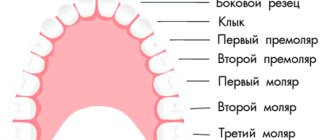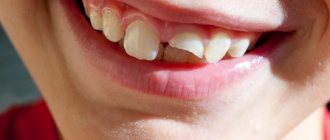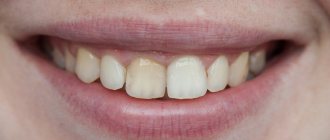Any problems with the baby's health cause concern among parents. But, when it comes to baby teeth, many do not attach importance to their defects and diseases. Experts strongly recommend promptly consulting a doctor at the first unwanted symptoms, since advanced cases threaten the development of serious complications. Pathological processes in the milk range can negatively affect the buds. If a tooth has darkened, be sure to show your child to the dentist - this is not only an aesthetic problem.
It is not always possible to restore the previous whiteness of a tooth. But in most cases, after several visits to the doctor and teaching the child to take proper oral care, the smile returns to its former attractiveness.
Bruise is the most common cause of tooth defects and discoloration.
More often, darkening of the tooth is observed after an impact. Young children are active and explore the world through play. Often their excessive activity leads to falls and, consequently, bruises. The greatest number of visits to the doctor with this problem occurs between the ages of 1–3 years. A child’s tooth can become damaged even after it has been replaced, since children reach their peak physical activity at 8–9 years of age. In addition to an accidental fall, other possible causes of tooth injury:
- An accident in which there was a blow to the jaw;
- bad habits, such as biting nails or the tip of a pen;
- playing sports;
- leisure;
- hitting a utensil - glass, spoon, etc.;
- biting into super hard food.
The structure of the primary occlusion is similar to the permanent one. Not everyone realizes that the first teeth also have roots, thanks to which they receive calcium and other necessary microelements from the periodontium. The pulp and network of nerve plexuses are responsible for the sensitivity and healthy condition of the tooth. This fragile system can be damaged by a strong impact.
Mechanical impact with a hard object on a tooth provokes damage to periodontal tissues. If the integrity of the neurovascular bundle is disrupted, hemorrhage may occur in the dentinal tubules and pulp tissue, which manifests itself in the form of staining or darkening of the tooth. Enamel also becomes dull due to a lack of nutrients supplied through damaged fibers and tissues.
Black teeth: what to do
The best way to solve the problem of black teeth is to see a doctor. The dentist will determine the cause of the color change and tell you how it can be eliminated. If your teeth have darkened due to the accumulation and staining of plaque, professional hygiene will help restore them to their original color. For example, contactless cleaning using the Air-flow method. If, in addition to plaque, tartar has formed on the teeth, this procedure can be combined with ultrasonic cleaning.
To eliminate the blackness that appears due to bacterial damage to dentin, you need to cure a carious tooth. This also applies to secondary caries. There are methods for lightening teeth that have changed color due to the components of filling materials. They are effective if the tooth has darkened by no more than 1-2 shades. If it is impossible to restore the natural color of the tooth, the dentist will suggest covering it with a crown or installing a veneer.
Our clinic’s specialists will restore the whiteness of your teeth, no matter why they have darkened. To consult with a doctor, make an appointment for a free initial appointment using the form on the website or by phone.
Why else can a tooth darken?
Other possible causes of the defect:
- caries;
- improper diet – predominance of carbohydrate foods;
- lack of calcium in enamel;
- incorrect treatment;
- violation of microflora in the oral cavity;
- taking certain medications;
- disruption of the endocrine system;
- Excessive ingestion of fluoride into the body during the formation of dental tissues - stains appear, merging into large darkened areas.
Parents may notice that the entire row of teeth near the gum line has darkened. This should raise suspicion of Priestley's plaque. This bacterial film appears during dysbacteriosis. If it stains, it becomes even darker.
Even if parents do not understand why their child’s tooth has darkened, it is important to visit a doctor on the first day after symptoms are detected. You especially shouldn’t put off a visit to the dentist’s office if you have a bruise.
Features of whitening at home
Home whitening of a dead tooth is a very convenient method, but in this case it very rarely provides the required effectiveness. This is explained by the fact that at home, as a rule, products are used that only have an external effect. Sometimes such methods are not enough to lighten the enamel and without introducing special components into the tooth cavity it is simply impossible to return it to its natural shade.
At home, whitening gels are usually used, which, after penetrating the enamel, activate chemical reactions in it. It is necessary to work with such substances with extreme caution, since there is a high risk of not only damaging the enamel structure, but also damaging the mucous membranes. Therefore, it is best to trust such procedures to specialists who can prevent possible risks.
Features of baby teeth
The first teeth of babies have porous, thin enamel, which cannot effectively resist the attack of harmful microorganisms. The pulp cavity is wide. Once bacteria gets inside, they spread quickly. If a child has a weakened immune system, the pathogenic process affects the “neighbors.” Carious lesions are possible even in a one-year-old baby. We are talking about the so-called “bottle” caries, when the baby falls asleep while feeding. The sweet mixture remaining in the mouth creates favorable conditions for the development of pathogenic microflora.
Since caries in children progresses quickly, after some time the dentin is damaged. A carious cavity forms inside. But there is not always a visible stain on top. Blackening of the tooth from the inside may occur. Various factors contribute to the development of caries:
- insufficient hygiene is a common occurrence in children;
- genetic predisposition;
- poor nutrition, including excessive consumption of sweets;
- the influence of negative factors during the formation of teeth in the embryo - previous illnesses of the pregnant woman, taking certain medications.
Saliva has antibacterial properties and helps neutralize bacteria. In children this function is not as pronounced as in adults. She is also depressed by non-compliance with hygiene rules and a large amount of sweets in the diet.
Symptoms accompanying tooth darkening
If the cause of the defect is a bruise, then the symptoms will be pronounced. More often, the impact damages the upper or lower front teeth. At the same time, the baby feels pain, which only increases over time. Pain is especially evident when pressing on a sore spot or chewing food. In addition to pain and staining, other symptoms may occur:
- poor tooth mobility;
- swelling of the gums;
- hyperemia;
- deformation of individual areas of the mucosa;
- formation of hematomas;
- increase in temperature (in some cases).
If the blow to the jaw was strong, the ligaments at the site of the injury may be torn, the joint may be damaged, or the alveolar process may be fractured. When trying to open or close the jaw, the child will experience pain.
Consequences of a tooth bruise
Darkening of the dentition provokes psychological discomfort, especially if these are the front teeth. Any injury does not go away without a trace. The tooth can be dislocated, cracked, broken, or sometimes embedded in the gum. Even if at the time of treatment the determination of the vital activity of the pulp gave a positive result, after the end of therapy it can still gradually die. This process is accompanied by damage to nerve endings, which provokes inflammation. More serious complications are also possible:
- cyst formation;
- manifestation of periodontitis;
- stopping root development.
These unpleasant consequences are possible in both baby and permanent teeth. Advanced pathology can even lead to tooth loss.
The rudiment of a permanent tooth often suffers from injury to a baby tooth. His enamel may develop poorly, and the risk of hypoplasia formation increases. The rudiment sometimes even dies.
Whitening prognosis and complications
Whitening a dead tooth is a fairly serious procedure that involves chemical action on tooth enamel. Therefore, before carrying out it, you should familiarize yourself with possible complications:
- the fragility of the result obtained, which necessitates repeated bleaching;
- The enamel of a dead tooth does not always acquire the same shade as healthy teeth. Even after lightening, the enamel can stand out from the rest;
- the enamel coating of a pulpless tooth after bleaching becomes even more fragile, in some patients it even begins to crumble and collapse;
- When applying the whitening component, the gums are irritated, so it should be done with extreme caution in patients prone to gingivitis, periodontitis and other pathologies.
Only a specialist can accurately determine whether intracanal bleaching is worthwhile or whether to look for safer alternative methods.
The Berezka dental clinic employs highly qualified specialists who can be trusted with complete confidence in tasks of any complexity and without worrying about unpleasant consequences.
How to diagnose
At the diagnostic stage, it is important to determine why the tooth has darkened. The doctor will perform palpation and visual examination. But in order to make an accurate diagnosis, assess the degree of damage or carious lesion, one cannot do without radiography. Based on its results, the doctor determines what to do to eliminate the problem. In some cases, consultation with other specialists, such as a gastroenterologist or endocrinologist, may be necessary.
X-rays can also be used to rule out a fracture of the root or alveolar process due to a bruise. If the periodontal area is damaged, the defect will definitely be visible on the image. After the impact, the dentist should monitor the condition of the pulp for several days. For this purpose, electroodontodiagnostic methods are used. If even initial signs of death are detected, the affected areas will be removed so that an inflammatory process does not develop.
Prevention
To prevent dental injuries, you must:
- Observe safety precautions at work, arrange the workplace and carry out potentially hazardous work in accordance with established rules.
- Properly equip playrooms for children and supervise children while playing.
- Follow traffic rules and use seat belts when traveling, as even minor emergency braking of the car carries a high risk of injury.
- Avoid conflict situations that lead to fights.
- Ensure the safety of sports games using special equipment (helmets, masks, dental guards).
- Carefully select sports grounds: they must comply with safety requirements.
What is the treatment
If the darkening of dental tissues is associated with dental diseases, the doctor will act according to the protocol. It is important to eliminate negative factors and carry out correct treatment. In case of caries, the dentist will remove the damaged tissue and install a filling. If the disease is advanced, endodontic treatment may be necessary, in which pulp removal is performed and the canals are filled. When pigmentation is caused by a general disease of the body, to eliminate it you need to cure the disease itself.
It is worth considering the situation in more detail if the tooth has darkened after an impact. What to do in this case? It all depends on the force of the impact and damage. If the bruise is not severe, most often only medical supervision is required (even up to 2-3 months) without any treatment. The tooth is provided with rest, excluding chewing and pressure on it. You need to remove solid food from your child’s diet for several days. To remove the load from baby teeth, their cutting edge is ground off. This technique is not used for indigenous people.
If the bruise is severe, the first thing you can do is give your child painkillers. The doctor’s actions depend on the clinical picture. If the pulp is damaged, they are gradual:
- tooth opening and pulp removal are carried out;
- the dental cavity is thoroughly disinfected;
- The channels are tightly filled with filling material.
If a permanent tooth has darkened as a result of a bruise, you can whiten it. After the procedure, the enamel will acquire a more or less natural color. To quickly restore oral health after injury, the dentist additionally prescribes physiotherapy and anti-inflammatory drugs.
Complete dislocation requires tooth extraction, after which the child’s condition returns to normal. In some cases, they may try to save the integrity of the dentition. To do this, the tooth is splinted using ligatures, caps, staples and other structures. The last steps are possible if the roots are sufficiently developed. Children aged 2–3 years often have to undergo removal.










